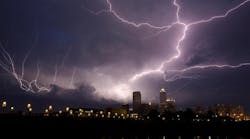A new inspection program certifying that the lightning protection systems installed at homes and businesses comply with national safety standards is growing rapidly in popularity and meeting customer demand with new features. The Lightning Protection Institute (LPI), which developed and operates the program, reported that 600 inspections were conducted in the United States and three foreign countries in 2012, a 200% increase in usage over the past year. The program became fully operational less than two years ago.
The Lightning Protection Institute-Inspection Program (LPI-IP) provides onsite inspection services, follow-up inspection reports and the issuance of certification for lightning protection systems that comply with LPI, National Fire Protection Association (NFPA), and Underwriters Laboratories (UL) standards.
The program recently reviewed the residential inspection service and revised pricing to provide an affordable option for lightning protection installing contractors and homeowners.
The program is serving a growing need expressed by property owners, insurers, and builders for a comprehensive third-party inspection approach for commercial and residential lightning protection projects, according to Tim Harger, who manages the LPI-IP program. “The LPI-IP provides quality assurance to property owners and their insurers and has quickly become the highest standard in the industry,” he said.
Insured losses related to damage from lightning strikes in the United States total around $1 billion each year, according to the Insurance Information Institute (I.I.I.). The I.I.I. puts the average lightning claim at $5,112 in 2011, up 5.5% from 2010. The average cost per claim rose 93% from 2004-2011, even as the actual number of paid claims fell by over 33% over the seven-year period. This decline may be due to increased use of lightning protection systems.
The LPI-IP offers several types of certificate and inspection options for structures, including office buildings, high-rise buildings, and single-family homes; limited scope inspections for only part of a structure, such as additions or cooling towers; an option for those with multiple buildings needing ongoing certifications and re-certifications for structures whose certificates have expired.
The LPI also operates a Campus Re-Inspection Program for sites having four or more buildings in a local area that require re-certification of their lightning protection systems. Certificates carry a three-year expiration date to complement the NFPA three-year code review process and keep pace with new technology.



